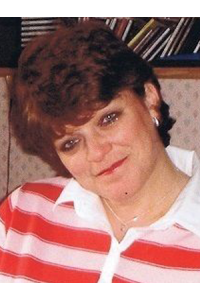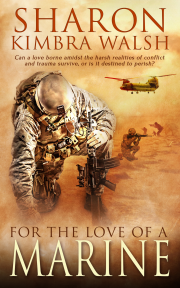PRINT
Afghanistan, a land of relentless temperatures, dust and sand with danger lurking at every turn and at every footfall, and a war that does not discriminate between enemy, friends or lovers.
Life on deployment is traumatic and fraught for Corporal Katie Walker, a career British Army Combat Trauma Medic. There is no time for relationships, they would create more complications than she can handle. Giving your heart to someone is to risk losing them and she has no intention of taking that enormous chance.
However, in the unlikeliest of places she meets US Marine Staff Sergeant Joe Anderson, a hardened, grizzled veteran and a ‘by the book’ career Marine. Committed to his mistress, the US Marine Corp, he has never wanted a woman until he meets the pretty medic.
Attraction between them is instantaneous and intense but living their lives on the edge, away from loved ones and the warmth of home, is what Katie and Joe feeling real or an illusion? When denial of their feelings overcomes duty and danger, they come to realise that love can bloom and flourish, bringing to two people a small piece of happiness and warmth amidst hardship and terror.
Born on the foundations of combat with its harsh realities, cruel environment and conflict, can their deep love for each other survive or is it destined to perish, destroyed by tragedy and loss?
Reader Advisory: This book contains scenes of violence.
General Release Date: 22nd September 2015
A blood-soaked combat boot, reclining on its side, lay tossed carelessly in a corner of the operating theater among torn and shredded webbing. Bandages and gauze soaked with crimson coiled in clumps on the floor, mixed in with remnants of charred and torn camouflage uniform. Personal effects, pitiful, tragic reminders of those who had been medevacked to the combat trauma hospital—CTH—lay scattered on a metal trolley, waiting to be identified and returned to those who had survived—or returned home with those who hadn’t.
Although the CTH was temperature controlled throughout, within Theater One it was hot and humid, the air thick with the coppery smell of blood and an all pervading stench of feces and urine. Dark blood had trickled then dripped from each operating table to pool in splatters on a dark green, rubberized floor, with smudged crimson footprints leading to and from the accumulating puddles where surgical teams and medical technicians had unknowingly trodden through them. Stainless steel instruments clinked mutedly against each other while in the background was the continuous whirr of an air conditioner, the periodic hissing of recycled air flowing in and out of the theater and the soft repetitive clunk from a clock on the wall.
CTH personnel clad in full-face plastic visors used to prevent blood spatter, white mesh face masks underneath, smears of blood adorning green surgical gowns or scrubs and gloves, crowded around the two occupied operating tables. Despite the blood-soaked surroundings and an atmosphere filled with palpable tension, there was no evidence of panic and no anxious overtones overriding smooth, professional voices as the two surgical teams bent all their efforts to saving the lives of the two unconscious young soldiers. Intense expressions of concentration were etched on many faces and requests for assistance and instruments were uttered in quiet, clear monotones. Both the blood and gore was ignored as though it did not exist.
Anyone looking into the busy room would have wondered at the almost emotionless and dispassionate air of the people working there, as though each one possessed an invisible mental shield that prevented them from becoming emotionally involved with their patients, something that each had subconsciously cultivated over the months of their deployment to protect themselves from the daily scenes of carnage and death, harsh realities of a combat zone. The shield was a necessity, a psychological barrier subconsciously erected to prevent burnout and breakdowns caused by unrelenting exposure to the cruel and unavoidable pressures of working in a combat hospital.
Corporal Katie Walker, twenty-six years of age, was a senior combat trauma medic—CTM—attached to the CTH. She was in her seventh year with the British Royal Army Medical Corp—RAMC—and on her first deployment to Afghanistan, assigned to Surgical Team One alongside another CTM. She had been in-country since March 2014 and had completed four months of a six-month tour.
During the early weeks of her deployment, Katie had experienced her own personal battles with trauma and stress. There had been many times when she had wondered if she would ever find the strength to complete her tour. Nightmares of explosions and maimed bodies had awakened her from sleep night after night, and on one occasion after a particularly lengthy duty, she had taken flight in tears to hide in the female locker room, saddened by the sight of so many brutally wounded and mentally shattered men and women being brought into the CTH. There had been other occasions when she had been on the brink of making a formal request for redeployment back to the United Kingdom, despite the adverse ramifications to her career that this might have brought about. The unpleasant experiences that she had been exposed to had caused her to reconsider how the human species treated one another.
As the long months had passed, however, like everyone deployed to Afghanistan, she had learned how to emotionally protect herself, had unknowingly developed the self-same protective shield as her colleagues—an ability to distance herself from adverse emotions and feelings. It wasn’t that she was emotionally cold or numb to the brutal daily truths of the combat world she inhabited. She was a human being with a great deal of compassion and sympathy for those she treated and tried to save, but her detachment was for her own protection, an emotionless armor that helped to harden her mind against the overwhelming pressures that she had to face.
That particular day had been an emotional one for them all. Three British soldiers out on foot patrol in a remote area of the Afghanistan desert had been injured in an improvised explosive device—IED—incident. One of the soldiers had stepped on a hidden mine lying undetected by a mine detector. The explosives, covered by a pile of razor-sharp stones and rocks, blending in with the surrounding terrain, had detonated, the resultant blast throwing shrapnel-like debris through the air, catching the soldier who had trodden on the mine and two others at ground zero. All three had sustained severe injuries and a combat trauma team—CTT—flown out by a Chinook combat trauma flight—CTF—had stabilized the casualties in the field before extracting and medevacking them back to the CTH at Camp Churchill, located in the British sector of Base Independence.
Three trauma teams, waiting outside the CTH, had immediately assessed the casualties then, while surgeons from three surgical teams scrubbed for the surgeries, the gravely injured soldiers had been swiftly taken to the trauma rooms, where the trauma teams standing by had immediately brought heavy bleeding under control, given full body assessments and checked vital signs then, following X-rays, all three were connected up to IV solutions and blood products to replace blood loss and stave off the onset of shock. A decision was made to prep the casualties for immediate surgery and rush them through to the operating theaters.
Three operating tables within Theaters One and Two were now in use. Each surgical team carrying out the surgeries consisted of surgeons who were specialists in their various fields, anesthetists, two surgical nurses and two CTMs. All the medical personnel excelled at what they did, each selected for deployment to the Afghanistan war theater specifically for their specialist skills and for their ability to be able to work under intense levels of pressure.
The surgeries that had been going on for most of the day were almost over, the casualties having come through their ordeals safely. If they remained stable and there were no complications over the next forty-eight hours, they would continue their recovery and rehabilitation back in the UK.
The tension in Theater One slowly began to dissipate and each surgical team began to relax. Conversation around the operating tables lightened in tone and there were a few subdued chuckles as someone made an obscure joke about a subject totally unrelated to the present situation.
Katie checked the IV line attached to her own patient again, tracing the fragile tubing leading from the triple branched cannula in the back of the young soldier’s hand up toward a collection of bags containing blood, plasma and saline fluid, ensuring that the life-sustaining products dripping downward were doing so at the correct speed and as freely as they should. She then placed two steady but sensitive fingertips on the casualty’s carotid artery and, with a sense of satisfaction, felt the strong throb of a pulse, confirming that the young British soldier continued to remain stable.
Nodding to the attending anesthetist that all remained well, Katie paused, taking a brief moment to gaze down at her patient. A hasty pre-op wash had removed much of the blood and dirt from the young man’s face and body, and now that she had a few minutes’ respite, she noticed with a deep sense of sadness that he was much younger than she had at first thought, probably in his early twenties, with shorn, dark hair. Stubble covered his chin and jaw line as though he had not shaved in some time, and his skin was pale, almost translucent, making him look as vulnerable as a child, a telltale sign of the trauma that had assaulted his body. He had obviously been out in the field for some time, as he appeared not to have washed in days and a strong smell exuded from his still body. Body odors from soldiers brought in from the field were a normal occurrence for the medical staff. The fetid smells barely stirred or offended their senses.
The young soldier’s injury from the IED explosion that day had resulted in the complete destruction of his lower left leg. Even though the golden hour for medevacking him back from the field to the CTH then assessment followed by surgery, was not breached, the leg had been too damaged and had been amputated just above the knee.
So young. The sad thought often intruded into Katie’s weary mind of late. What will he do now? His Army career had been abruptly and cruelly terminated, the lifestyle to which he had been accustomed had changed irrevocably. He could go on to lead a relatively normal life—most amputees did, and adapted and coped well. With counseling and rehabilitation, the young man would resume his life, but the harsh reality was that it had changed forever. There would be no going back to reclaim what he had once had and moving forward would be the ultimate test for him.
A sudden movement caught Katie’s attention, disturbing her thoughts about the patient. Leading surgeon Major Josh Macintyre of Surgical Team One had stepped back from the operating table. Stripping off his bloody surgical gloves, he raised his plastic visor and pulled down his face mask. Rubbing his eyes tiredly, he once again inspected the heavily bandaged stump of the soldier’s amputated limb before commenting wearily in a broad but lilting Scottish accent, “Well, that’s it, ladies and gentleman. That’s all we can do for the poor wee laddie. As long as infection does’na set in and he remains stable, he’ll do. Thank you all for your assistance.”
Major Macintyre turned away from the operating table, his body posture stooping now as though all the adrenaline and energy that he had drawn on to save his patient’s life had drained away. He walked toward the door of the theater, feet shuffling in their protective bootees, and left, Katie knowing full well that he would make his way unerringly down the long corridor to the R&R—rest and recuperation-room—at its far end.
Lance Corporal Henry Barrow, Katie’s CTM colleague on Surgical Team One, left the theater unbidden, unknowingly leaving a trail of bloody footprints behind him. He returned moments later pushing a gurney that he aligned lengthwise against the operating table. The five remaining members of the surgical team positioned themselves to each side of the patient and, with Katie carefully handling the IV stand, lifted the young soldier gently onto the gurney.
With the lance corporal pushing and Katie wheeling the IV stand and keeping an observant eye on her patient for any downward turn in his condition, they left the theater, turned left down the long corridor and, moving at a steady pace, guided the gurney with its precious passenger some meters until they arrived at the critical care unit—CCU—beyond the wards on the right. Lance Corporal Barrow and Katie wheeled the patient into the brightly lit CCU where four trauma nurses awaited their arrival. Working in well-honed synchronization, the two CTMs transferred the still-sleeping soldier to a pristine white hospital bed, ensuring that the sheets and blanket were tucked securely about his motionless body.

Sharon spent eight and a half years in the Women’s Royal Air Force. Originally based in London, after she met her husband, Sharon relocated to Scotland to settle in Edinburgh. Already loving the country after having been stationed there during her time in the military, Sharon has never looked back. She lives with her husband and rescue West Highland Terrier, Snowie, (who thinks that she is a Rottweiler in disguise).
In 2014 Sharon started to have visions of writing a contemporary military romance. The ideas started to pile up and there was nothing for it but to get them down on her laptop, regardless of time and place.
You can take a look at Sharon's website here.














